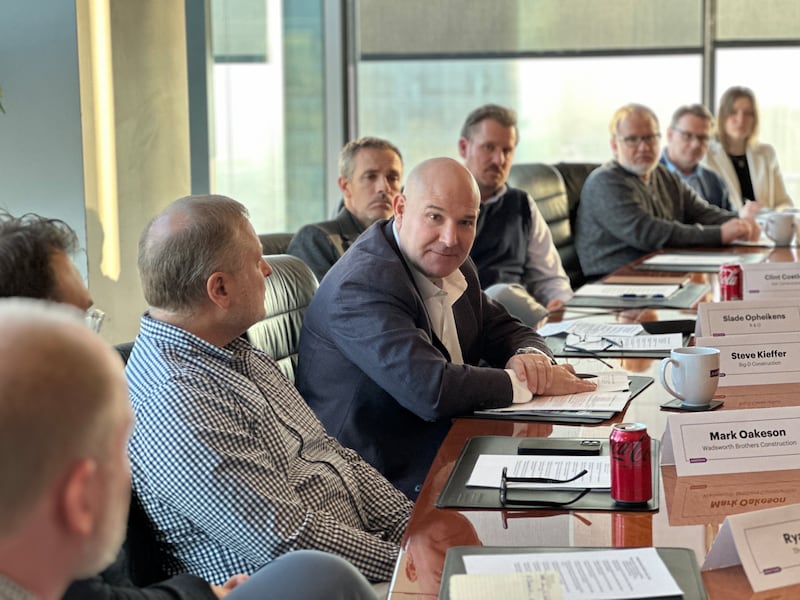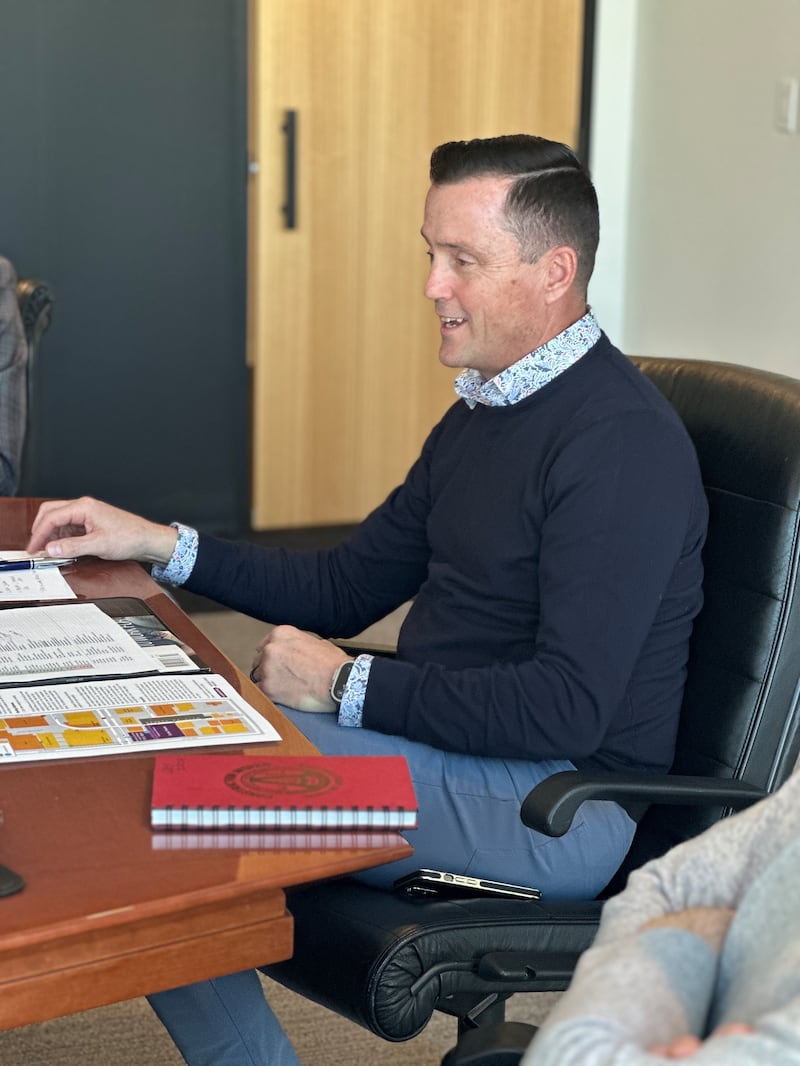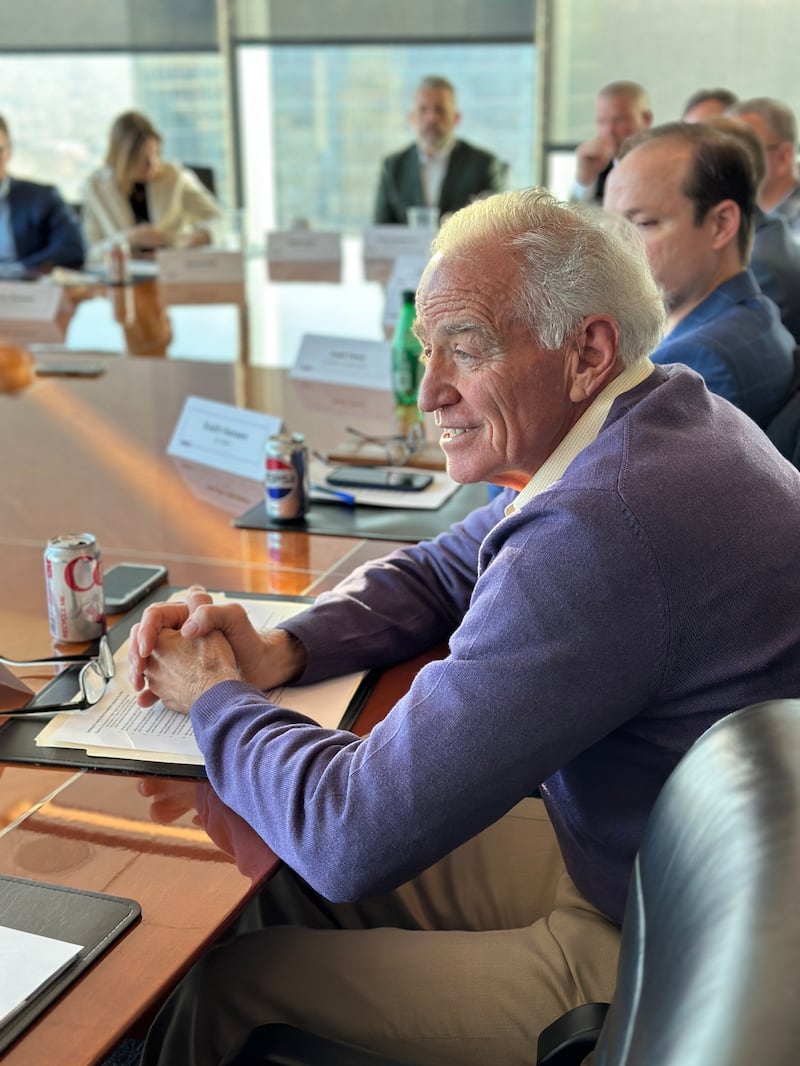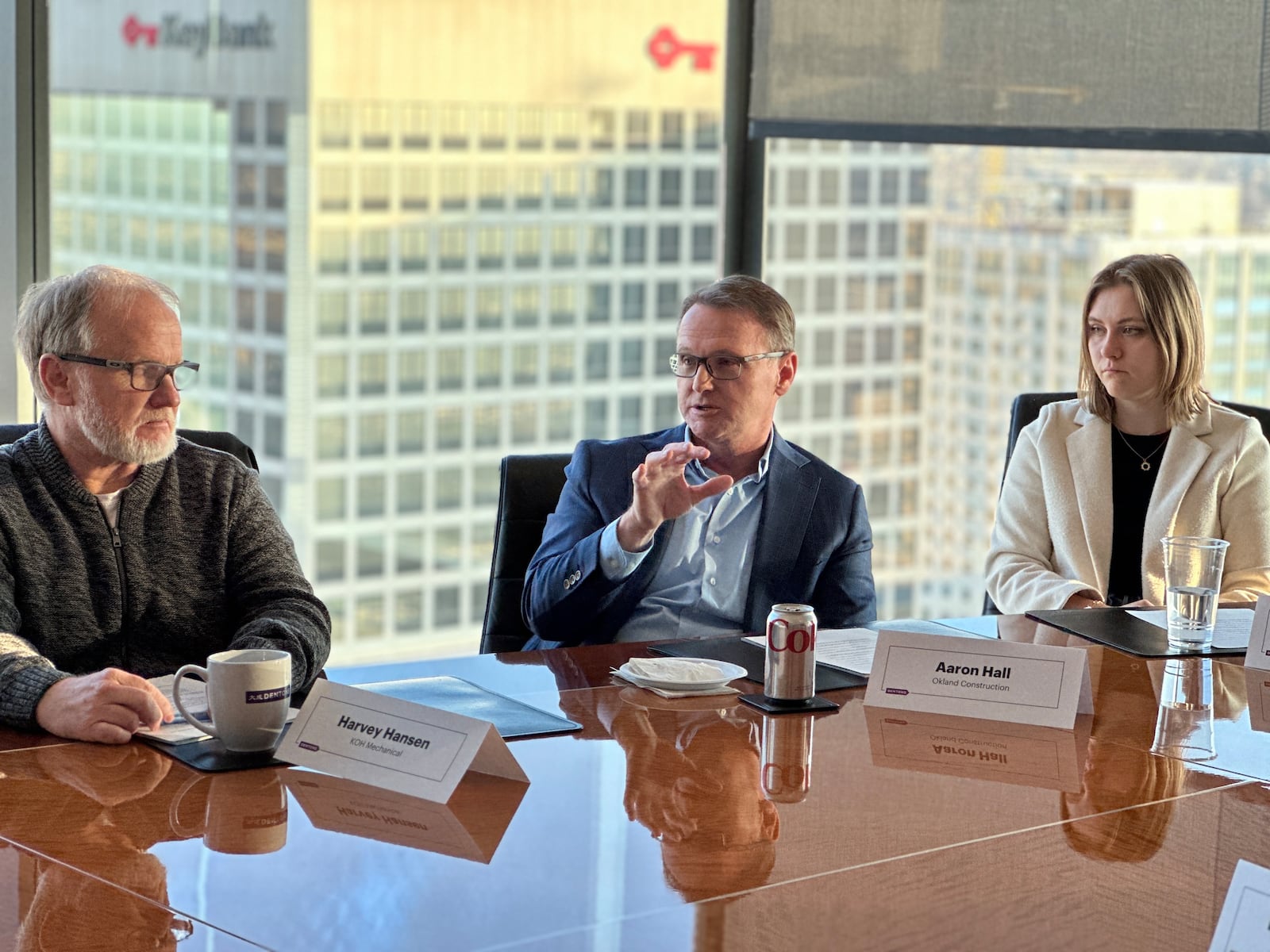This story appears in the February issue of Utah Business. Subscribe.
Last month, Utah Business partnered with Dentons Durham Jones Pinegar to host a roundtable featuring local leaders in building and construction. This conversation was moderated by Joey Gilbert, CEO and president of the AGC of Utah.
What’s the current status of Utah’s construction industry?
Dave Whimpey | VP | Layton Construction
Labor shortages have been a challenge for everybody here and continue to be a challenge for safety, schedule and quality, but the industry continues to be robust with a good backlog.
Ryan Bevan | President, Construction | Gardner Group
I’ve been at Gardner for about 15 years, and our bread and butter for all those years has been office. We’ve done everything else, but office is really strong. Since 2020, there’s been a big shift. We’ve pivoted strongly into multifamily and industrial. We’re not seeing a lot of influx in office, although we’re backfilling lots of vacant space.
Dave Wesemann | CEO & President | Spectrum Engineers
From the design perspective, we’re very busy, which means that 12-18 months from now, construction will continue to be busy. We’re seeing a lot of work in housing, not office, but healthcare, education and the technology industry with AI coming on. Data centers are going to be huge.
Keith Hansen | Partner & Architect | AE Urbia
The architecture industry is very busy. As Utah’s population continues to grow, the need and desire for an experience … grows. We are seeing tremendous growth in projects just released within the past month. The desire is there, but the number of people we have is not. The difficulty we’re having is finding a way to funnel all the projects through and complete them on time.
Carl Tippets | President | Pentalon Construction
In 2021, there was a 56 percent increase in permits for multifamily in the state. Those products are all coming online in the last bit, but permits have fallen dramatically in the last two years. … If you get product in the ground now, you’ll be online to take advantage of the upcoming shortage.
Tayler Fox | Attorney | Dentons
I do a lot of lien law. We record them, and we litigate them. We do a lot of construction defects, contract disputes, payment disputes and change order issues. … In December, I spent two hours arguing at the Utah Supreme Court on a case that was only supposed to be 40 minutes. We went for two hours because the justices had a lot of questions. They spent a lot of time with me trying to understand the lien loss statute. There will be a decision coming down that I think will be important to your industry on preliminary notices, the lien statute and how it relates to allocation of work when you’re doing condominium units. I think that’ll be an interesting case to watch for.

What are the most significant challenges we’re facing as an industry in 2025? How are we going to address them?
Victor Fuchs | CEO & President | Helix Electric LLC
Manpower is a huge challenge here. We are seeing it all over the place. In Nevada, for the electrical industry, there are certain licensing requirements that are not reciprocal in other states. The challenge is getting electricians. We work very hard internally to train our people, … but demand for the skilled trade is very high.
Steve Kieffer | VP | Big-D Construction
Tariffs are going to be a big issue. We’ll see what happens soon. That’s one thing that can really impact us with immigration and with labor. I think that, locally, power will be a big issue — specifically with these data centers and the power needs.
Dave Whimpey | VP | Layton Construction
Another challenge with big projects is that data centers and AI tend to suck up a lot of the skilled labor. Big projects impact the smaller projects through the available labor in the market, especially when you have an out-of-town client offering incentive pay. These things make it difficult for local, smaller companies to compete. There is a tendency to draw the labor pool to the big projects, which creates more of a challenge for the balance of the market and projects.
Harvey Hansen | President | KOH Mechanical Contractors
As consumers, we need to do better in our licensing. I don’t want to make it hard to get skilled laborers, but … we need to ensure that [everyone is] following the Utah standards. … It might not affect us now, but it will.

How are sustainability practices shaped in construction? What steps are being taken to meet environmental goals?
Aaron Hall | Director, Operations | Okland Construction
We must solve [the issues of] energy, water and air quality. … We can’t solve [these problems] on the path we’re on without a lot more work with the entire community, especially our leaders. … It’s not one thing that’s going to solve it all. We need to be able to advocate and help embrace some of the things that help drive more efficiency.
Josh Fenn | VP, Project Executive | Jacobsen Construction
Salt Lake City has a standard that at least 55 percent [of demolished building materials] must be recycled. How can we embrace that and look for that opportunity? … For Jacobson, it is getting away from gas-powered equipment. There are battery options that are safer for our employees as they’re working around fumes. Battery-powered equipment was not feasible years ago. In less than five years, it has really [grown]. … For the workers actually doing the work, the equipment is often lighter and safer. Sustainability affects the environment and our personal health, but productivity and other factors can help us be even more convinced of sustainability in day-to-day operations.

What measures can we take to protect the safety of our workers and pay attention to their mental health?
Slade Opheikens | CEO & President | R&O Construction
If you haven’t been to AGC’s website, you should go and look at the work that has been done. … They have a tab for mental health [with] a lot of resources, and they’re all free. They need to be shared, though. … It starts with us and has to be more than an email, billboard or training session. We have to openly talk about it and really ask people how they are doing.
Steve Kieffer | VP | Big-D Construction
We’ve created a peer support hotline for our employees. We also have professional hotlines available. We’ve partnered with our healthcare partner to provide 12 therapy sessions to all our employees. We tell everybody to ask how [people are] doing — truly find out. We ask all of our onsite field teams to check in with everybody. Management has to check in, too; it’s a trickle-down effect. [We need to] know how people are and see if they’re in a good place. If they’re not, get them help.
Victor Fuchs | CEO & President | Helix Electric LLC
I feel there is not enough emphasis on safety on job sites. More and more, I walk onto the job site, and people are walking around with no PPE. … The general contractors, probably the ones outside this room, are not enforcing those standards, and then there are incidents. We’ve seen incidents and fatalities, and it all could have been prevented. I don’t think there is enough emphasis in the industry.
Aaron Hall | Director, Operations | Okland Construction
I think the stigma [surrounding mental health] in a predominantly male industry is very real. It’s like an iceberg. There’s an unspoken mass of shame, worry, concern, ego — whatever you can chalk it up to — combined with the realities of mental health that creeps up on all of us. I think it’s a lot bigger than most of us realize until we are faced with it, with someone at work or in our personal lives. Access to care is huge, and I think the industry needs to provide more trained resources. What we can do in our spheres of influence is train on awareness. … We may not have access to all the professional care yet, but that one step will open up our ability to bring things out of some of that darkness and help our people [know they are] not alone. That’s huge.
Mark Oakeson | Commercial Division Manager | Wadsworth Brothers Construction
I’ve found that the best way to bridge the gap from management to in-line supervision is to show them you’re willing to do battle with them. … Work with them. Sometimes, when we’re trying to make tight deadlines, I’ve been put on jobs by superintendents. When they see I’m willing to get down on their level and do things shoulder-to-shoulder, they understand I care for them.
David Hill | Executive Director | Utah Plumbing Heating Contractors Association
Executive Director | American Subcontractors Association, Utah Chapter
I represent a lot of the subcontractor companies here in the state, and many of you recognize the value of those subcontractors, but there are other times that project teams in bigger companies might not understand. … I think there needs to be a real understanding amongst the general contractors and the subcontractors that just because [something] has to be done, … you can’t force [subcontractors] beyond their abilities because of an owner’s schedule. They’re not machines. They’re human beings. They need to take time off to go to the dentist.

How are current trends in technology transforming construction processes and projects?
Dave Wesemann | CEO & President | Spectrum Engineers
One thing that’s happened, and is happening more, is a collaboration between design, engineering, contracting and the owner. We use online cloud tools where everybody can see what’s going on at once. Owners are adopting processes where engineers, architects and contractors work together … from the beginning and get real-time feedback on costs.
Keith Hansen | Partner & Architect | AE Urbia
One client had great experiences using VR goggles, and they’re integrating this into augmented reality onsite. Of course, the amount of time it has taken to put all this together has been incredible, but we’re seeing things that I’ve never seen in the industry before. … And we wouldn’t have done it if we didn’t have an owner who pushed us and said, “We want this in order to save on the back end of the construction process.”
Kelly Chatterton | VP | Utah Ready Mix (representing Kilgore Companies)
From a safety standpoint, we’re using AI in all of our [vehicles], … monitoring the drivers, their speed and coaching in real-time, but also looking for drowsy driving. A lot of things have advanced to help keep our people safe. At first, they were resistant. Now, they appreciate it. It has helped them reduce incidents. We’ve had guys get cut off on the road who would’ve gotten a ticket, but we immediately sent the highway patrolman the video of what the other car did, and they were the ones cited.
Clint Costley | President | Keir Construction
We utilize AI to analyze safety trends, forecast and evaluate contracts. It’s fun to go back and enter something into ChatGPT or ConsensusDocs and find things I’ve agreed to that I would’ve had no idea otherwise. … Technology is not to be feared, just like mental health is not to be feared, just like safety practices are not to be feared. … Embracing our younger workforce and how they will build in the future is the challenge we have with tech today.
Dave Hogan | President | Wadman Corporation
Safety and AI have been interesting for us. I’m sure everybody’s doing some form of it. We have robots that walk certain job sites, [taking] video and 360 pictures. Then, the AI [analyzes] safety issues on the job site. I thought it was neat that it doesn’t seem as confrontational. You’re just sending [in the information]. “Here you go. What do you think about this? This is what you guys are doing, correct?” Instantly, no argument. It’s not like two humans have to debate whether they’re in compliance or not. It’s like, “Here’s the data. Get it under compliance.”
Ryan Bevan | President, Construction | Gardner Group
From an owner’s perspective, it’s nice to see the reporting we get from the tech. We require a weekly report, and it’s nice to have the drone footage. … When we go in a couple of years down the road and inspect the building, we’ll come back to some of our contractors and say, “Hey, was this assembly built correctly?” We can then go back to these photos and show [that yes,] this system was done correctly. It’s almost like an insurance policy for us. We don’t have to deconstruct something or prove it was done correctly.
Eric Calder | VP | Zwick Construction
It’s exciting to see technology in construction; it’s here to stay. There are a lot of robust opportunities for it to grow. One thing we need to remember is that it’s key to think of the fundamentals of the information we’re providing. We’ve got to be really good at the information we put into the systems that we use. If we don’t have [good] information for [AI] to draw upon, it isn’t as useful as it could be.

What role can education play in addressing our needs as an industry?
Josh Fenn | VP, Project Executive | Jacobsen Construction
The student associations are excited to perform but lack practical application. Some of the feedback I’ve been given is, “Why weren’t we taught this in the past four years?” … I would plead with legislation, as it looks at the boards of education in the states, to review that and allow industry leaders to have insight into what the curriculum is. … It’s got to come from us.
Slade Opheikens | CEO & President | R&O Construction
There are a lot of details that can’t be built. Just because somebody can put it on paper doesn’t mean it can actually happen in the field. … It should be mandatory [for designers to] spend a year in the field. They should have to carry a hammer, pick up a shovel and know what it feels like before they can get their architectural or construction management degree.
Mark Oakeson | Commercial Division Manager | Wadsworth Brothers Construction
If I had my preference, every member of a design team would be somebody out of the field. I’ve had more success advancing or promoting guys who have been carpenters, bringing them into a management role where they may have to do some construction engineering or some project engineering. That’s just gone so much better.
Carl Tippets | President | Pentalon Construction
The focus needs to shift from the university level to K-12. By the time people hit university, they’re looking for management jobs. … You rarely get a kid who graduates from college wanting to be a carpenter or an electrician. We’ve got to get them back and shape that expectation down at a lower level when they’re still making career decisions.
David Hill | Executive Director | Utah Plumbing Heating Contractors Association
Executive Director | American Subcontractors Association, Utah Chapter
For plumbing, the average age of an apprentice getting his journeyman is between 24 and 26 years old. … Plumbers are making six figures. That’s something we need to communicate better.
Harvey Hansen | President | KOH Mechanical Contractors
To me, it’s the counselors. Counselors in schools all come from a college, and that’s how they think it needs to be. I’ve been to a maturation class where the guy taught that if you did not go to college, you would make $50,000 a year, but if you went to college, you’d be making $120,000 a year. That’s not true. We’ve got to push these counselors to know that there’s a great career path without college.
What would you say to a parent about the benefits of their son or daughter pursuing a career in the construction industry?
Dave Hogan | President | Wadman Corporation
I would reach out to the parents of kids struggling in high school who don’t want to go to school. They don’t like sitting in a classroom. They’re kinesthetic learners. That kid is going to excel in the industry. A lot of times, it’s the disruptive kids. Then they get into construction with a strong personality, and we can settle them down and give them something to do.
Clint Costley | President | Keir Construction
It starts with work ethic, honestly. If you teach a child how to work, they can embrace our industry in full force. … Whether it’s the computer-based or field-based side of our business, having a willingness to work will get them where they need to be.


